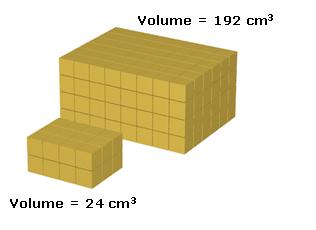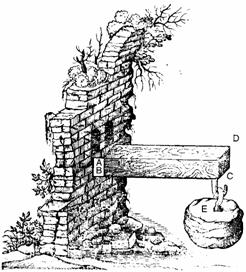
Length, Area and Volume
The Pythagorean Theorem in Three Dimensions
Suppose a box is 24 inches long, 15 inches wide, and 12 inches tall. A thin rod is placed in this box so one end is at one corner and the other end at the opposite corner:

If we look at the shadow of the rod on the bottom of the box, its length can be found by the Pythagorean Theorem:
![]()

Now the shadow and the right edge of the box are legs of a right triangle, so we can use the Pythagorean Theorem again to find the length of the rod:
![]()

In general, if the length, width and height of a right, rectangular prism (a box) have lengths a, b and c, then the length, d, of the longest diagonal is given by the following three-dimensional version of the Pythagorean Theorem:

Area vs Length
Area is measured in square units, such as square inches, square centimeters, etc. These units can be thought of as little squares that are 1 unit on a side, and area is a measure of how many of these units will fit inside a closed region. Of course, we sometimes have to think of fractions of these units. Length, on the other hand, is a "linear measure" and can be thought of as the number of "unit segments" that can be placed along a line or curve. For example, a rectangle that measures 3 cm by 5 cm has an area of 15 square centimeters and a perimeter (which is a linear measure) of 16 cm:


When we speak of the area of a three-dimensional solid, we usually mean the total surface area. Sometimes this can be found by constructing a net and adding the areas of each part of the net. In any case, the concept of area is the same and is a measure of the number of square units that can cover the surface of the object.
When converting between different units, do not confuse linear conversions with area conversions. For example, a foot is equal to 12 inches, but a square foot is not equal to 12 square inches, because a square that is 1 foot on each side contains 144 square inches:

Example 1:
The solid below is made of 5 cubes that are 1 cm on a side. What is its surface area?

Solution:
Find the surface area of each view:

From these views, we can see that the total area is 22 cm2.
Volume
Volume is measured in cubic units, such as cubic inches or cubic centimeters. A cubic unit can be thought of as a cube that is 1 unit on each side, and the volume of a solid can be thought of as the number of such cubes that can be placed inside it, allowing for fractions of these cubes if necessary. In addition, the weights of solids made of the same material are proportional to their volumes since volume is the amount of "stuff" an object is made of.
The following box has a perimeter (all 6 edges) of 36 cm, an area of 52 cm2 (the total of the front, back, top, bottom, left, and right sides) and a volume of 24 cm3 (two layers of 12 cubes per layer):

As with area, when you convert units of measure, the units of volume are cubes of the units of length. For example, 1 cubic foot is equal to 1728 cubic inches, because 123 = 1278.
Scaling
Suppose a rectangle measures 2 inches by 3 inches and a similar rectangle is twice as long. Then that other rectangle measures 4 inches by 6 inches. The perimeter of the second rectangle is twice the perimeter of the first rectangle because 4+6+4+6=2(2+3+2+3), but the area is 4 times as great. When we construct a similar figure by a scaling factor of s, all linear measures of the scaled figure will be s times as great as the original figure, but the area will be s2 times as great. This applies to three-dimensional figures as well as two-dimensional figures.
Now suppose we have two boxes. The first is 4 cm long, 3 cm wide, and 2 cm high as in our previous example, and the second is a scaled version with a scaling factor of 2. Then all linear measures of the scaled box will be twice as long as the corresponding measures of the original, all area measures will be 4 times as great, and the volume will be 8 times as great:

In 1638 Galileo wrote his final book, The Discourses and Mathematical Demonstrations Relating to Two New Sciences, a scientific testament covering much of his work in physics over the preceding thirty years. Galileo proposed a new science, the study of the strength of materials, that considered how the size and shape of structural members affects their ability to carry and transmit loads. He discovered that as the length of a beam increases, its strength decreases, unless you increase the thickness and breadth at an even greater rate. You cannot, therefore, simply double or triple the dimensions of a beam, and expect it to carry double or triple the load. This led Galileo to recognize what we now call the scaling problem: There are limits to how big nature can make a tree, or an animal, for beyond a certain limit, the branches of the tree or the limbs of the animal, will break under their own weight.
 The main point was that the strength of a beam or other elongated object, such as an arm or the limb of a tree, is proportional to the area of a cross-section, whereas its weight is proportional to its volume. Galileo argued if a rock almost but not quite heavy enough to break a beam of a certain thickness is hung from a beam and then another rock of twice that size is hung from another beam twice as long and thick, the second rock will break the second beam because its weight has increased by a factor of 8, whereas a cross-section of the beam has only increased by a factor of 4. In other words, a large structure proportional in exactly the same way as a smaller one must necessarily be weaker. The illustration on the right is from Galileo's last book.
The main point was that the strength of a beam or other elongated object, such as an arm or the limb of a tree, is proportional to the area of a cross-section, whereas its weight is proportional to its volume. Galileo argued if a rock almost but not quite heavy enough to break a beam of a certain thickness is hung from a beam and then another rock of twice that size is hung from another beam twice as long and thick, the second rock will break the second beam because its weight has increased by a factor of 8, whereas a cross-section of the beam has only increased by a factor of 4. In other words, a large structure proportional in exactly the same way as a smaller one must necessarily be weaker. The illustration on the right is from Galileo's last book.
As a consequence, movie characters like King Kong couldn't exist because they would collapse under their own weight.
Example 2:
 An artist made an aluminum scale model of a sculpture. The scale model is 2 feet tall, and the actual sculpture, also made out of aluminum, is 8 feet tall.
An artist made an aluminum scale model of a sculpture. The scale model is 2 feet tall, and the actual sculpture, also made out of aluminum, is 8 feet tall.
a. The scale model weighs 20 lbs. What is the weight of the actual sculpture?
b. The area of a face of the cube in the scale model is 16 in2. What is the area of the corresponding face in the actual sculpture?
c. What is the volume of the cube in the actual sculpture?
Solution:
The scaling factor is 4 since 4 ∙ 2 ft = 8 ft.
a. The weight is proportional to the volume, and the volume is scaled by a factor of 43 = 64, so the weight of the actual sculpture is 64 ∙ 20 lbs = 1280 lbs.
b. Areas are scaled by a factor of 42 = 16, so the area of the corresponding face in the actual sculpture is 16 ∙ 16 in2 = 256 in2.
c. Since the area of a face of the cube in the scale model is 16 in2, each side is 4 in. In the actual sculpture, each face of the corresponding cube would therefore be 4 ∙ 4 in = 16 in, so the volume of that cube would be (16 in)3 = 4096 in3.
Return to Lesson 12